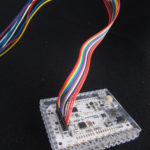With the growing adoption of 3D printing and increased access to printers, 3D printing has become a viable option for use in the creation of 3D models for accessible graphics.
Mapping
 Maps prove to be ideal candidates for the use of 3D printing an assist in the important area of orientation and mobility. 3D printed maps can be easier to understand than traditional raised line drawings and are useful for both blind and sighted alike. However, maps often contain much more information than can be easily conveyed by the 3D print itself. For example, braille labels require such considerable space for ease of reading that they are not able to convey much information. To explore this area, Monash University’s SensiLab team have augmented 3D models with simple touch sensors and Arduino technology to enable touch-triggered audio feedback. This feedback can be static, such as providing basic building information, or dynamic, detailing time-dependent information. Research in this area has been applied in the creation of Monash University’s accessible Caulfield campus map and Vision Australia’s accessible floorplans.
Maps prove to be ideal candidates for the use of 3D printing an assist in the important area of orientation and mobility. 3D printed maps can be easier to understand than traditional raised line drawings and are useful for both blind and sighted alike. However, maps often contain much more information than can be easily conveyed by the 3D print itself. For example, braille labels require such considerable space for ease of reading that they are not able to convey much information. To explore this area, Monash University’s SensiLab team have augmented 3D models with simple touch sensors and Arduino technology to enable touch-triggered audio feedback. This feedback can be static, such as providing basic building information, or dynamic, detailing time-dependent information. Research in this area has been applied in the creation of Monash University’s accessible Caulfield campus map and Vision Australia’s accessible floorplans.
Education
Essential graphics included in textbook materials for Australian school students are provided in alternative format, most often as a description or tactile graphic. However, tactile reading skills must be taught and the visual conventions they use can be difficult for a blind person to understand. 3D printing offers a new, inexpensive and easily distributed method of creating 3D models as an additional format. In a project with Insight Education for the Vision Impaired, we worked closely with classroom teachers and aides to identify areas in which 3D printing can be valuable for vision impaired children in schools, such as models to support the curriculum in science, maths and geography; test materials; as aides for teaching concepts of tactile literacy; maps of the school and excursion locations; and classroom modifications such as magnifier stands.
In 2018 a further project in this area will commence in collaboration with the Victorian Department of Education and Training and Statewide Vision Research Centre.
And beyond
Contextual information that is not explicitly taught in school is still important as a means of supporting an understanding of the world, enriching engagement and providing access to leisure and the arts. Monash University partnered with the Bendigo Art Gallery to explore technologies for making artworks accessible.
Publications
“3D Printed Street Crossings: Supporting Orientation and Mobility for People who are Blind or have Low Vision“, CHI Conference on Human Factors in Human Computing, 2022. * Best Paper Award
“Touch Reading 3D Prints“, JSPEVI Journal of the South Pacific Educators in Vision Impairment, 2021.
“Accessible Interactive 3D Models for Blind and Low-Vision People“, ASSETS International ACM SIGACCESS Conference on Computers and Accessibility, 2021.
“Smooth Sailing? Autoethnography of Recreational Travel by a Blind Person“, ASSETS International ACM SIGACCESS Conference on Computers and Accessibility, 2020.
“Hey Model!” – Natural User Interactions and Agency in Accessible Interactive 3D Models“, CHI Conference on Human Factors in Computing Systems, 2020.
“3D Printed Maps and Icons for Inclusion: Testing in the Wild by People who are Blind or Have Low Vision“, ASSETS International ACM SIGACCESS Conference on Computers and Accessibility, 2019.
“Accessible Maps for the Blind: Comparing 3D Printed Models with Tactile Graphics“, CHI Conference on Human Factors in Computing Systems, Montreal Canada, 2018.
Last updated: September 5, 2022 at 8:42 am